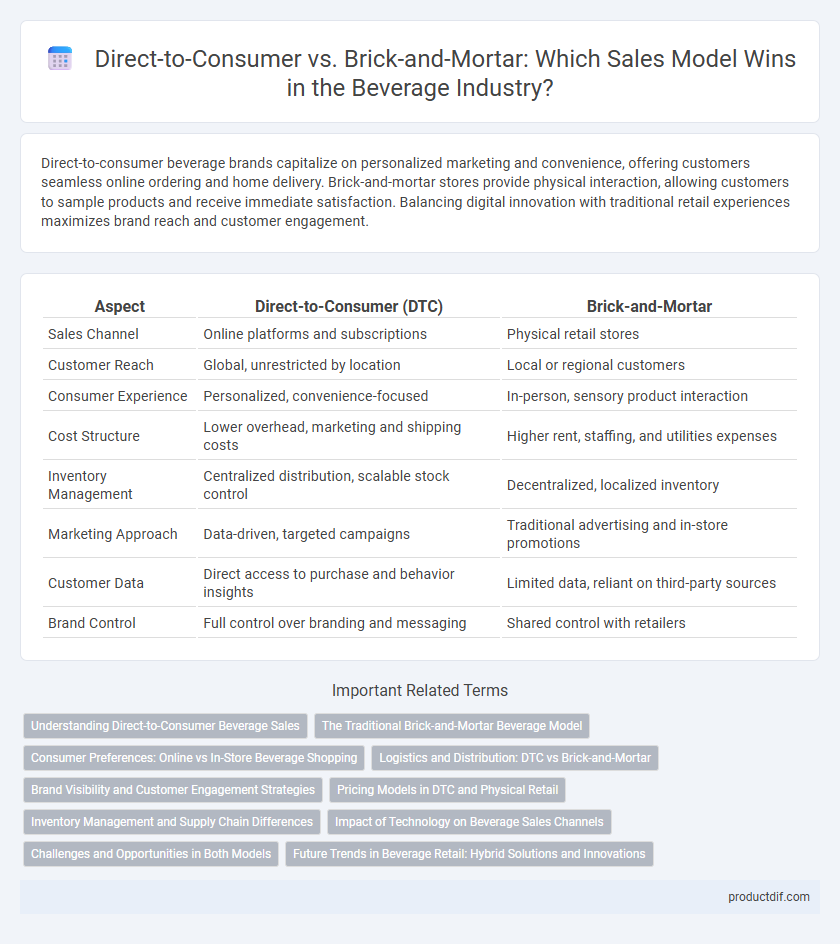Direct-to-consumer beverage brands capitalize on personalized marketing and convenience, offering customers seamless online ordering and home delivery. Brick-and-mortar stores provide physical interaction, allowing customers to sample products and receive immediate satisfaction. Balancing digital innovation with traditional retail experiences maximizes brand reach and customer engagement.
Table of Comparison
| Aspect | Direct-to-Consumer (DTC) | Brick-and-Mortar |
|---|---|---|
| Sales Channel | Online platforms and subscriptions | Physical retail stores |
| Customer Reach | Global, unrestricted by location | Local or regional customers |
| Consumer Experience | Personalized, convenience-focused | In-person, sensory product interaction |
| Cost Structure | Lower overhead, marketing and shipping costs | Higher rent, staffing, and utilities expenses |
| Inventory Management | Centralized distribution, scalable stock control | Decentralized, localized inventory |
| Marketing Approach | Data-driven, targeted campaigns | Traditional advertising and in-store promotions |
| Customer Data | Direct access to purchase and behavior insights | Limited data, reliant on third-party sources |
| Brand Control | Full control over branding and messaging | Shared control with retailers |
Understanding Direct-to-Consumer Beverage Sales
Direct-to-consumer (D2C) beverage sales leverage online platforms to deliver products directly from manufacturers to consumers, bypassing traditional retail channels. This model enables beverage brands to gather valuable consumer data, personalize marketing strategies, and increase profit margins by eliminating intermediaries. Enhanced convenience and access to exclusive products drive consumer preference for D2C beverage purchasing over brick-and-mortar stores.
The Traditional Brick-and-Mortar Beverage Model
The traditional brick-and-mortar beverage model relies heavily on physical retail locations such as grocery stores, bars, and cafes to distribute products. This model emphasizes face-to-face customer interactions, in-store merchandising, and immediate product availability without shipping delays. Revenue generation depends on foot traffic, local market presence, and partnerships with distributors and retailers.
Consumer Preferences: Online vs In-Store Beverage Shopping
Consumers show a growing preference for online beverage shopping due to convenience, wider selection, and personalized recommendations driven by data analytics. In-store purchases remain popular among buyers valuing immediate product access, sensory evaluation, and social shopping experiences. Beverage brands optimize strategies by integrating seamless e-commerce platforms with experiential retail environments to meet diverse consumer expectations.
Logistics and Distribution: DTC vs Brick-and-Mortar
Direct-to-consumer (DTC) beverage brands leverage advanced logistics technologies like real-time tracking and automated warehouses to streamline direct shipments, reducing delivery times and enhancing customer satisfaction. Brick-and-mortar distribution relies heavily on established supply chains and regional distribution centers to ensure product availability, often incurring higher inventory carrying costs. Efficient DTC logistics minimize intermediaries, cutting overhead and enabling precise demand forecasting, whereas traditional retail faces challenges managing restocking cycles and shelf space constraints.
Brand Visibility and Customer Engagement Strategies
Direct-to-consumer beverage brands leverage e-commerce platforms and social media to enhance brand visibility through targeted digital advertising and personalized content, driving higher customer engagement. Brick-and-mortar stores offer tactile brand experiences and immediate product access, fostering loyalty through in-person tastings and direct customer interactions. Integrating omnichannel strategies maximizes reach by combining online data analytics with physical presence, optimizing both visibility and engagement.
Pricing Models in DTC and Physical Retail
Direct-to-Consumer (DTC) pricing models often leverage dynamic pricing strategies, subscription plans, and exclusive online discounts to enhance customer retention and maximize profit margins. Brick-and-Mortar retail pricing typically involves markup strategies reflecting overhead costs such as rent and staff, with in-store promotions aimed at driving foot traffic. Data shows that DTC brands can offer 10-30% lower prices compared to physical stores due to reduced operational expenses and direct supplier relationships.
Inventory Management and Supply Chain Differences
Direct-to-consumer beverage brands maintain lean inventories by leveraging real-time data and just-in-time supply chain strategies, reducing storage costs and minimizing waste. Brick-and-mortar retailers require larger inventory buffers to meet immediate consumer demand, necessitating more complex logistics and warehousing solutions. Supply chain efficiency in direct-to-consumer models depends heavily on direct shipping and digital order fulfillment, whereas brick-and-mortar relies on bulk distribution channels and in-store replenishment cycles.
Impact of Technology on Beverage Sales Channels
Technology has revolutionized beverage sales channels by enabling Direct-to-Consumer (DTC) platforms to offer personalized shopping experiences and streamlined ordering processes through mobile apps and AI-driven recommendations. Brick-and-Mortar stores integrate digital tools like augmented reality and contactless payments to enhance customer engagement and convenience. The rise of data analytics in both channels allows beverage brands to optimize inventory management and tailor marketing strategies to consumer preferences efficiently.
Challenges and Opportunities in Both Models
Direct-to-consumer beverage brands face challenges such as high customer acquisition costs and logistics complexities but benefit from direct customer insights and higher profit margins. Brick-and-mortar stores offer established foot traffic and immediate product accessibility but struggle with inventory management and rising operational costs. Both models present opportunities for omni-channel strategies that leverage data analytics and personalized marketing to optimize sales and customer experience.
Future Trends in Beverage Retail: Hybrid Solutions and Innovations
Hybrid solutions in beverage retail combine Direct-to-Consumer (DTC) models with traditional brick-and-mortar experiences to enhance customer engagement and convenience. Innovations such as AI-driven personalization, augmented reality tasting sessions, and seamless omnichannel integration are shaping the future, enabling brands to offer tailored product recommendations and interactive shopping. This convergence supports sustainable growth by leveraging data analytics to optimize inventory management and customer loyalty programs.
Direct-to-Consumer vs Brick-and-Mortar Infographic

 productdif.com
productdif.com